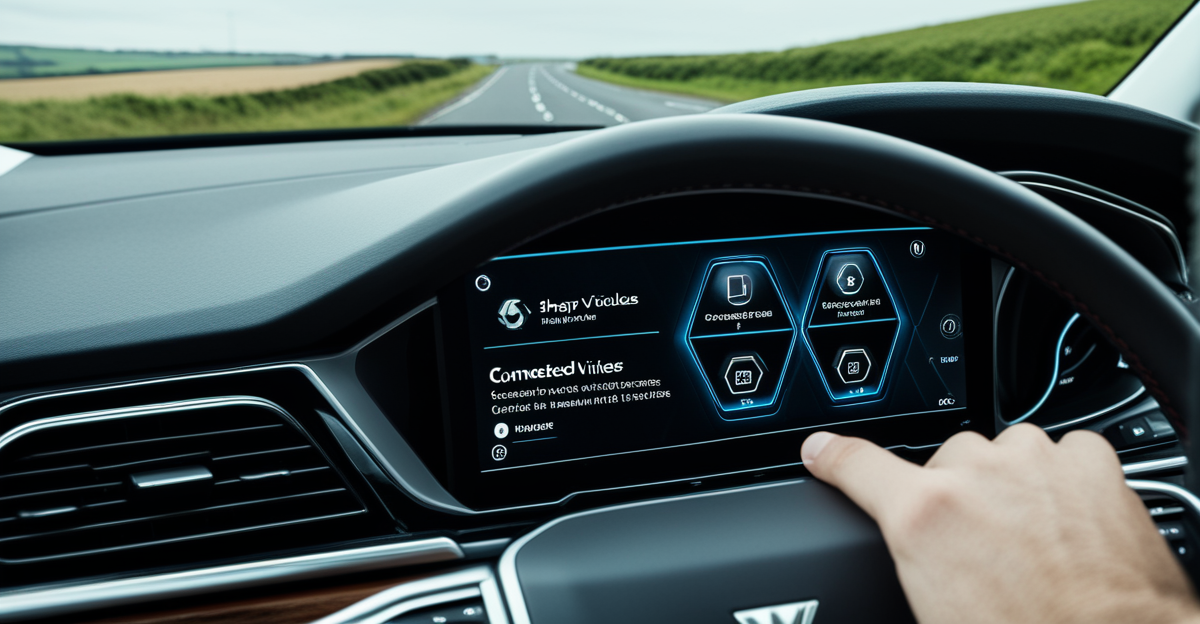Enhanced Safety Features of Connected Vehicles
Connected vehicles are transforming road safety with advanced technologies like Vehicle-to-Vehicle (V2V) and Vehicle-to-Infrastructure (V2I) communication. These technologies allow vehicles to anticipate potential collisions by exchanging data with each other and nearby infrastructure, leading to a significant decrease in accident rates. Studies suggest that V2V and V2I can reduce collisions by over 80%, highlighting the potential of connected vehicle safety benefits.
Experts assert that vehicle connectivity will be instrumental in future road safety, emphasizing its role in enhanced road safety by predicting traffic patterns and preventing accidents before they occur. This predictive capability of connected vehicles not only improves safety but also fosters confidence among drivers, as they can make informed decisions in real-time.
Also read : Exploring the Future of Electric Vehicles in the UK
Moreover, collaborative data sharing from connected vehicles enhances road safety by integrating with existing traffic systems, ensuring a streamlined flow. As vehicle connectivity continues to evolve, experts predict a safer and more efficient driving environment, ultimately saving lives and reducing injury severity.
Convenience for the Driver
Connected vehicles are not only about safety but also redefine driver convenience through technology. At the forefront is smart navigation, which enables seamless travel by determining optimal routes and adjusting in real-time to avoid congestion and road obstructions. These advanced systems often interface with smartphones, providing drivers with a user-friendly experience and ensuring that important travel updates are at their fingertips.
Also to discover : What role does innovation play in the competitiveness of the UK automotive sector?
For UK drivers, connected vehicles integrate smoothly with personal devices, offering infotainment systems and voice commands, enhancing the overall travel experience. In real-life scenarios, this connectivity means a driver in, for example, central London, can comfortably receive real-time traffic updates or access nearby amenities, all through their vehicle’s interface, thus simplifying the journey. As these technologies continue to evolve, the potential for connected vehicle convenience remains vast, catering to both the tech-savvy and everyday driver alike.
Cost-Effectiveness of Connected Vehicles
Connected vehicles are not just about cutting-edge convenience; they bring significant cost savings to drivers. By optimizing fuel efficiency, these vehicles help reduce fuel consumption by taking the most efficient routes and adjusting driving patterns in real-time. Enhanced maintenance benefits also contribute to cost-effectiveness. These smart vehicles are equipped with systems that monitor the vehicle’s performance, alerting the owner to potential issues before they become costly repairs.
In comparing ownership costs between connected vehicles and traditional ones, drivers stand to benefit from reduced long-term expenses. The ability of connected vehicles to operate more efficiently means fewer fuel stops and delayed mechanical wear, reducing overall maintenance costs.
Real-life case studies in the UK illustrate these economic advantages. Many UK consumers have reported noticeable savings, emphasizing the importance of these vehicles in the current economic climate. With connected vehicles, drivers can enjoy both modern technology and appreciable financial benefits.
Improved Traffic Management and Reduced Congestion
Connected vehicles play a pivotal role in enhancing traffic management and mitigating congestion challenges. These vehicles act as crucial components in smart city solutions, communicating directly with traffic systems to ensure smoother vehicular flows. They achieve this by leveraging real-time data exchange capabilities, thereby allowing traffic lights, signs, and road condition data to interact seamlessly with vehicles. This results in efficient routing and adjustment strategies that significantly ease traffic bottlenecks.
Urban congestion presents a substantial issue across various UK cities, where dense population centers consistently face gridlock. The adoption of connected vehicle technology offers insights into potential resolutions. By integrating connected vehicles into traffic management strategies, cities like London and Birmingham can optimize flow, reducing commute times and potentially cutting travel delays by up to 20% based on current pilot studies.
In the UK, several pilot programs have been put into action, demonstrating promising results. These initiatives are designed to provide firsthand insights into the practical applications and advantages of connected vehicles, thereby setting benchmarks for their broader adoption. Through continuous evaluation and technological refinement, connected vehicle integration promises to revolutionize urban mobility, paving the way for reduced congestion and enhanced city living.
Environmental Impact and Sustainability
Connected vehicles are increasingly contributing to environmental benefits, particularly through their role in sustainable transportation. By optimizing routes and driving patterns, these vehicles significantly reduce fuel consumption, leading to lower emissions of harmful pollutants. Statistics indicate that vehicles utilizing these technologies can cut emissions by up to 30%. This reduction in emissions supports larger climate change efforts in the UK, showcasing the potential for smarter, cleaner driving experiences.
Moreover, sustainability initiatives in connected vehicle technology are continually evolving. These initiatives focus not only on reducing emissions but also on integrating renewable energy sources wherever possible. For example, some connected vehicle programs in the UK are exploring solar-powered charging stations to enhance the sustainability of electric vehicles, which are naturally aligned with lower environmental impact goals.
The environmental impact of connected vehicles also contributes significantly to national targets for emission reductions, supporting the UK’s commitment to become carbon-neutral by 2050. This integration of advanced technology with ecological objectives highlights the harmonious relationship between innovation and environmental stewardship. The ongoing advancements in this field suggest a promising alignment between connected vehicle enthusiasts and environmental advocates.
Real-Life Examples and Case Studies in the UK
The emergence of connected vehicle technology in the UK is paving the way for innovative transformations in transportation. By examining UK connected vehicle case studies, we gain valuable insights into how this technology is shaping real-world applications and consumer experiences. Current pilot projects, such as those in Manchester and Bristol, showcase significant advancements. These initiatives have demonstrated tangible benefits in accident reduction, traffic management, and emissions control.
Consumers using connected vehicles in everyday life have shared impactful experiences. For instance, drivers in Birmingham have reported substantial improvements in journey times due to efficient traffic management systems integrated with connected vehicles. They appreciate the convenience of real-time data updates, which allow agile navigation through congested areas, ultimately transforming urban mobility.
Looking to the future, these studies indicates promising directions for connected vehicles in the UK. Projections suggest a continued emphasis on enhancing consumer experiences. As the technology evolves, connected vehicles are expected to further integrate with sustainable energy solutions, setting a precedent for eco-friendly transportation alternatives. These advancements have the potential to revolutionize the daily commute, providing UK consumers with not just a mode of transport, but a holistic, efficient, and environmentally conscious travel experience.




